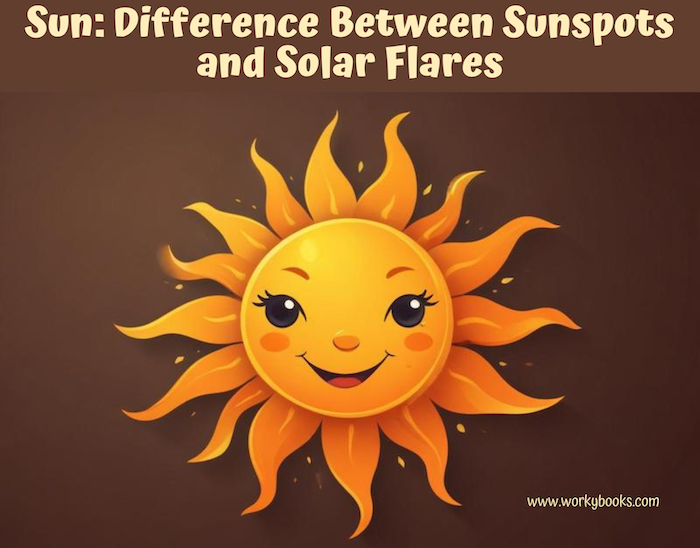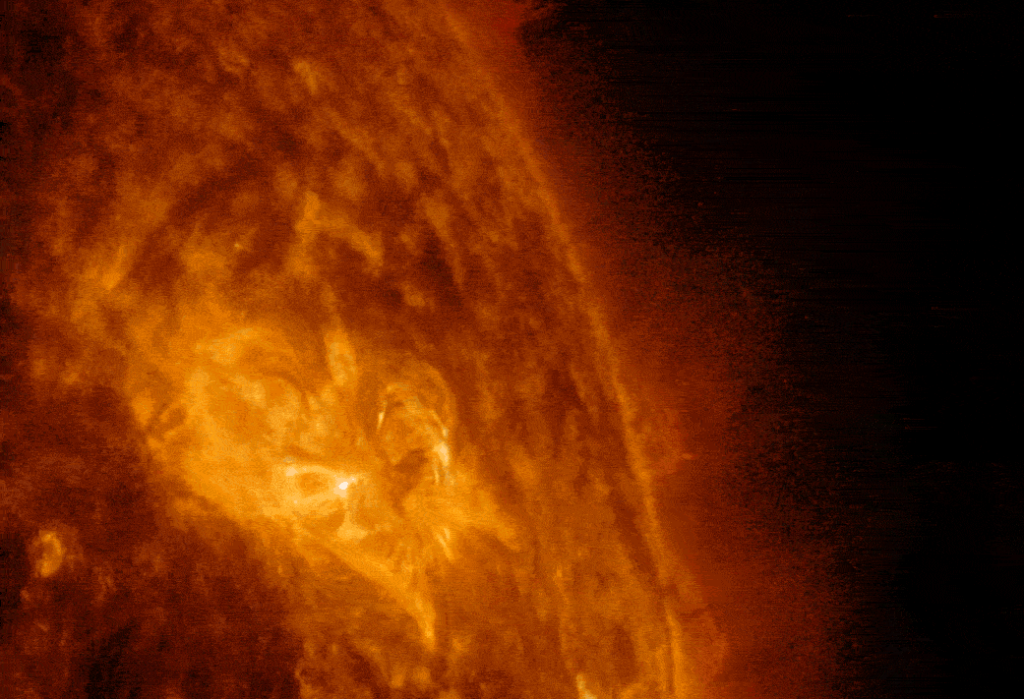Difference Between Sunspots and Solar Flares

Hey there, young explorers! Let’s talk about two fascinating things that happen on our Sun: sunspots and solar flares.
Difference between sunspots and solar flares?
Imagine the Sun as a big, bright ball of gas. Sometimes, there are dark spots on its surface that look like freckles. These are called sunspots! Sunspots are cooler areas on the Sun’s surface. They look dark because they are not as hot as the rest of the Sun’s surface. Sunspots are caused by strong magnetic fields on the Sun that prevent heat from reaching the surface in those spots.
Now, let’s talk about solar flares. Solar flares are like giant explosions on the Sun’s surface! They happen when the Sun’s magnetic fields get all tangled up and then suddenly snap, releasing a huge burst of energy. This energy is sent out into space as light, heat, and charged particles.
So, while sunspots are dark, cool areas on the Sun’s surface, solar flares are bright, hot explosions that release a lot of energy into space.
Here’s a fun way to remember the difference: Imagine you have a big, round chocolate chip cookie. The chocolate chips are like sunspots – they’re darker and cooler than the rest of the cookie. Now, imagine some of the chocolate chips suddenly explode, sending bits of chocolate flying everywhere. Those explosive chocolate chips are like solar flares!
Both sunspots and solar flares are important to study because they can affect Earth in different ways, like causing beautiful auroras or sometimes disrupting our communication systems.
How are sunspots and solar flares similar?
While sunspots and solar flares are different, they do have some things in common. Let’s explore their similarities in a way that’s easy to understand.
- Both happen on the Sun: Sunspots and solar flares both occur on the surface of our Sun. They are like different events happening in the same place, just like how you might have a birthday party and a game night in your house.
- Both are caused by the Sun’s magnetic fields: The Sun has powerful magnetic fields, which are like invisible lines of force. These magnetic fields are responsible for creating both sunspots and solar flares. It’s like how a magnet can make paper clips stick together or push them apart.
- They often happen together: Sunspots and solar flares are like best friends – they often show up together! Many times, solar flares occur near sunspots or in regions where sunspots are present.
- They can affect Earth: Both sunspots and solar flares can have an impact on our planet Earth. Sunspots can sometimes make the Earth a little cooler, while solar flares can cause amazing light shows in the sky called auroras and sometimes disrupt our radios and satellites.
So, even though sunspots and solar flares are different, they are similar in many ways. They both happen on the Sun, are caused by the Sun’s magnetic fields, often occur together, and can have an effect on our Earth.
Here are 3 teaching resources in the form of informational passages that be used by 5th grade teachers to understand the Sun and its phenomena.
Informational Text 1:Sunspots and Solar Flares
Sunspots and solar flares are two amazing things that happen on the Sun, but they are different in some ways. Sunspots are dark, cool areas on the Sun’s surface. They look like freckles and are caused by strong magnetic fields that block heat from coming up. Sunspots can last for days or even months!
On the other hand, solar flares are like huge explosions on the Sun. They happen when the magnetic fields get all tangled up and then suddenly snap, releasing a lot of energy and light. Solar flares are super bright and hot, and they only last for a short time, from a few minutes to a few hours.
Both sunspots and solar flares are caused by the Sun’s magnetic fields, but they have different effects on the Earth. Sunspots can sometimes make it a little harder for us to use radios and GPS, while solar flares can create beautiful auroras and sometimes cause problems with satellites and power grids.
In a way, sunspots and solar flares are like siblings – they come from the same place (the Sun) and are caused by similar things (magnetic fields), but they look and act differently!
Multiple Choice Questions:
- What do sunspots look like on the Sun’s surface?
a) Freckles
b) Explosions
c) Bright lights
d) Rainbows - How long can solar flares last?
a) A few seconds
b) A few minutes to a few hours
c) Several days
d) Several months - Which of these can solar flares cause on Earth?
a) Auroras
b) Rainbows
c) Tsunamis
d) Earthquakes
Free Response Questions:
- How are sunspots and solar flares similar?
- What are some differences between sunspots and solar flares?
This informational text is an excellent resource for teachers who want to introduce their 4th-grade students to the fascinating concepts of sunspots and solar flares. Written in accordance with CCSS.ELA-LITERACY.RI.5.5, this passage effectively compares and contrasts these two solar phenomena, highlighting their similarities and differences in a way that is easy for young learners to understand.
This comparison also encourages critical thinking and promotes a deeper understanding of the similarities and differences between the two solar events.To assess students’ comprehension, the resource provides three multiple-choice questions and two free-response questions. These questions are designed to test students’ understanding of the key concepts presented in the text and encourage them to think critically about the information they have learned
Informational Text 2: Sunspots
Sunspots are dark areas on the Sun’s surface that appear as spots. They are caused by strong magnetic activity, which reduces the temperature in those areas compared to the surrounding regions. Sunspots are usually found in pairs or groups and can last for a few days to a few months.
Sunspots are cooler than the rest of the Sun’s surface, with temperatures around 4,000°C (7,232°F), while the surrounding areas can reach 5,500°C (9,932°F). Although sunspots appear dark, they are still very bright and hot compared to Earth’s standards.
The number of sunspots varies over an 11-year cycle, known as the solar cycle. During the peak of this cycle, called the solar maximum, the number of sunspots increases. Conversely, during the solar minimum, the number of sunspots decreases.
Sunspots can have effects on Earth. They can cause minor disruptions in radio communications and navigation systems when they are particularly active. However, they can also produce beautiful auroras, known as the Northern and Southern Lights, near Earth’s poles.
Multiple Choice Questions:
- What causes sunspots?
a) Strong magnetic activity
b) High temperatures
c) Solar flares
d) Solar prominences - How long can sunspots last?
a) A few hours
b) A few days to a few months
c) Several years
d) They are permanent features - During which phase of the solar cycle are there more sunspots?
a) Solar minimum
b) Solar maximum
c) Solar eclipse
d) Solar equinox
Free Response Questions:
- How do the temperatures of sunspots compare to the surrounding areas on the Sun’s surface?
- Describe one effect sunspots can have on Earth.
This informational text on sunspots is an excellent resource for teachers to use when discussing the Sun and its features with fifth-grade students. The text aligns with CCSS.ELA-LITERACY.RI.5.3 by explaining the relationship between sunspots and the solar cycle. Additionally, the text supports NGSS 5-ESS1-1 by addressing the concept of apparent brightness. This information can be used to support a discussion on the apparent brightness of the Sun and other stars, and how their relative distances from Earth affect their perceived brightness.

In this image, you can see an active region on the sun with dark sunspots. Image credit: NASA/SDO/AIA/HMI/Goddard Space Flight Center
Informational Text 3: Solar Flares
Solar flares are sudden, intense bursts of energy released from the Sun’s surface. They occur when the Sun’s magnetic fields become tangled and release a huge amount of energy in the form of light, heat, and radiation. Solar flares can last from a few minutes to several hours.
The energy released during a solar flare can be equivalent to millions of hydrogen bombs exploding simultaneously. This energy is released across the entire electromagnetic spectrum, from radio waves to gamma rays.
Solar flares are classified based on their intensity, with X-class flares being the strongest, followed by M-class and C-class flares. The most powerful solar flares can have significant effects on Earth, such as disrupting radio communications, damaging satellites, and causing power outages.
However, Earth’s atmosphere and magnetic field protect us from the harmful radiation emitted by solar flares. In fact, solar flares can produce stunning auroras, as the charged particles interact with Earth’s magnetic field and atmosphere.

NASA’s Solar Dynamics Observatory captured this imagery of a solar flare, as seen in the bright flash. A loop of solar material, a coronal mass ejection (CME), can also be seen rising up off the right limb of the Sun. Image credit: NASA/SDO/Goddard
Multiple Choice Questions:
- What causes solar flares?
a) Tangled magnetic fields on the Sun’s surface
b) Sunspots
c) Solar prominences
d) Earth’s magnetic field - Which class of solar flares is the strongest?
a) C-class
b) M-class
c) X-class
d) S-class - How long can solar flares last?
a) A few seconds
b) A few minutes to several hours
c) Several days
d) Several weeks
Free Response Questions:
- Across which parts of the electromagnetic spectrum is energy released during a solar flare?
- How does Earth’s atmosphere and magnetic field protect us from the harmful effects of solar flares?
This informational text on solar flares is a resource for fifth-grade teachers discussing the Sun and its impact on Earth. The text aligns with CCSS.ELA-LITERACY.RI.5.3 by explaining the relationship between solar flares and the Sun’s magnetic fields, as well as the interactions between solar flares and Earth’s radio communications, satellites, and power systems. The specific information provided in the text supports students’ understanding of these relationships and interactions.
The multiple-choice and short form questions accompanying the text help teachers assess students’ understanding and promote critical thinking skills. By using this informational text, teachers can effectively guide their students in understanding solar flares, their causes, and their consequences, while aligning with CCSS standards and supporting the discussion of NGSS concepts.
Here is another blog on Sun for kids.
